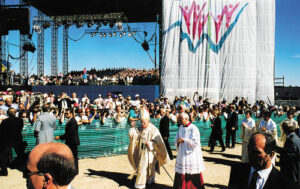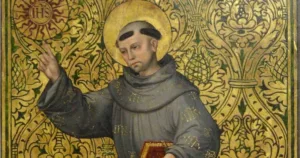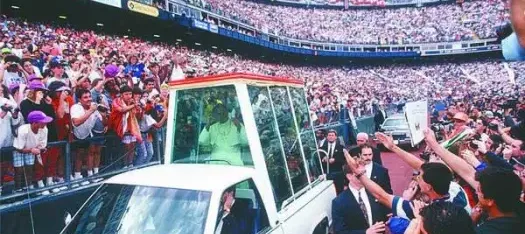Thirty years ago this month, I attended World Youth Day (WYD) in Denver, CO with Pope John Paul II. It took place days before my 15th birthday. Some estimates believe one million people showed up to the events at the old Mile High Stadium (see above photo) and the final Mass at Cherry Creek Reservoir (see below photo.) My own mother was one of the chaperones for WYD ’93 and my little brother (12 years old at the time) was one of thousands treated by Denver General Paramedics for dehydration at the final reservoir Mass. This was a special event for my family since Denver is where we were born and raised.

I also attended WYD in Paris in 1997 as a 19 year old, just before beginning a premature study-abroad at University of Paris that same year. As I blogged about here, I attended WYD in Rio De Janeiro where I ended up asking teenagers to stop making out at the final Mass on Copacabana Beach. Yes, they were making out during Mass. Even CNN has recently dubbed the events of Lisbon 2023 to be a “Catholic Woodstock.”
Neo-con non-trads usually defend such events by saying many young people are “evangelized” at these events and it’s worth some trouble. Besides the fact the last English-based catechesis I went to in Rio before the final Mass (led by an Irish group back in 2013) was total heresy, we need to realize that the Mass was never the means of evangelization in any time of Church history. I know this seems weird to say to our world of “Catholic Woodstock” lovers, but it’s just further proof that we’re not following the Faith that grew over a billion followers when we were doing it the right way.
Here’s how the faith spread in every century:
The early Church had the Mass of the Catechumens and the Mass of the Faithful. The first half was Scripture readings. The second half was the Offertory and Sacrifice. No pagans were ever allowed in the second half. The pagans who had proved themselves not to be Roman spies were allowed to attend the Mass of the Catechumens (hence the name) even before their own baptism. However, this was only allowed after showing significant interest in Christianity. And in some circles “significant interest” was probably a readiness to endure martyrdom even before baptism. The point is that in the early Church, pagans were reached through charity and quiet sharing of the new faith, not by inviting them to Holy Mass. The Mass was not the means of evangelization in the early Church. It was peak worship, not entry-level worshiop.
The Medieval Church had millions of Catholics attending Holy Mass, but there was never an indiscriminate approach to the altar as we see today. Probably most good Catholics received Holy Communion between one and twenty times a year in the Middle Ages. (I’m glad Pope Pius X dialed this up a bit, but he of course never expected the Church hierarchy to encourage the level of total sacrilege we see in heretical documents like Amoris Laetitia that literally tells divorced and “remarried” people they can receive Holy Communion without an annulment.) In any case, the Medieval Church did their catechesis at home and in other times on top of the sermon that was preached on Sunday. I believe the reason the modernist Church feels the need to isolate all “evangelization” into the Mass is because modernists don’t usually want to give God more than one of their 168 hours a week. Learning the faith in the middle ages happened mostly outside the Mass.
In fact, World Youth Days and youth groups themselves are related to the fact that very little catechesis happens in the modern Catholic family at home. Whether loud youth gatherings are the cause or the effect or simply the poor remedy to the broken Catholic family structure, I do not know. But it’s all definitely related to no home-catechesis.

Great Revivals of the Catholic Church often took place under saints. One example would be the great Franciscan named St. Bernadine of Siena (above.) He would preach to 30,000 people for many hours about heaven and hell. There would be dozens of confessors on stand-by at these outdoor events to hear confessions. There is no evidence that Mass was the center of one of these “Revivals” in Europe in the early 15th century. Of course, it can be assumed that St. Bernadine of Siena offered a private Mass or a conventual Mass with his community the morning of such an event. But hours of preaching on heaven and hell and Jesus Christ and the Blessed Virgin Mary did not require reception of the Eucharist to ensure a full conversion of the tens of thousands of people who gathered to hear a live-saint preach the Gospel like an Apostle. The Mass was the most important part of the day for St. Bernadine, but getting the Eucharist to as many mortal-sinners as possible was not his goal. Getting conversion to as many sinners as possible was his goal.
The Missionary Church following Trent did not use the Mass as a means of Evangelization. Consider St. Francis Xavier who baptized hundreds of thousands in the Eastern Hemisphere in the 16th century or St. Peter Claver who baptized hundreds of thousands in the Western Hemisphere in the 17th century. Both great Jesuit saints explained the faith to people never seen by European eyes via translators. How did they explain the ancient Catholic Faith? They explained heaven as the location to follow a life with Jesus and the sacraments and hell for those who rejected the Catholic Church. They explained the Creed and the Our Father, not liberation theology (bad) or even salvation history (good.) In fact, even the Counsel of Trent explains that supernatural faith must precede the reception of the sacraments. Thus, the sacraments are not magic-tricks to incite faith if young people are not learning the true traditional Catholic Faith first.
The old-school approach of prioritizing the ascetical life ahead of a shallow reception of the sacraments seems to have contributed to the making of a billion converts to the Catholic Faith, where the Western Hemisphere since Vatican II has lost probably about 50 million Catholics to evangelical communities of Protestants. Why? It turns out when we Catholics try to evangelize like Protestants or hippies at a “Catholic Woodstock” (as CNN accurately calls WYD) then we lose millions of people. But when we do it as the saints have always done it—namely, catechesis outside of Mass—then we make countless converts of people who will attend Holy Mass worthily… but usually at a later date, often following their initial experience of receiving true evangelization on what is at stake for their souls in accepting Christ and the Catholic Church.
The Mass is the highest-form of Christian worship, and for that reason it was not a means of outreach during any time of Catholic Church history before the 1980s. Only when it is cheapened does it become an “evangelization event.”
